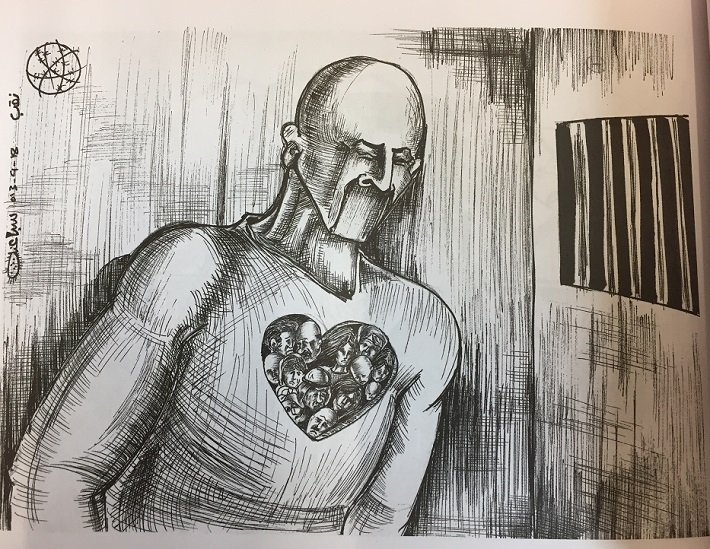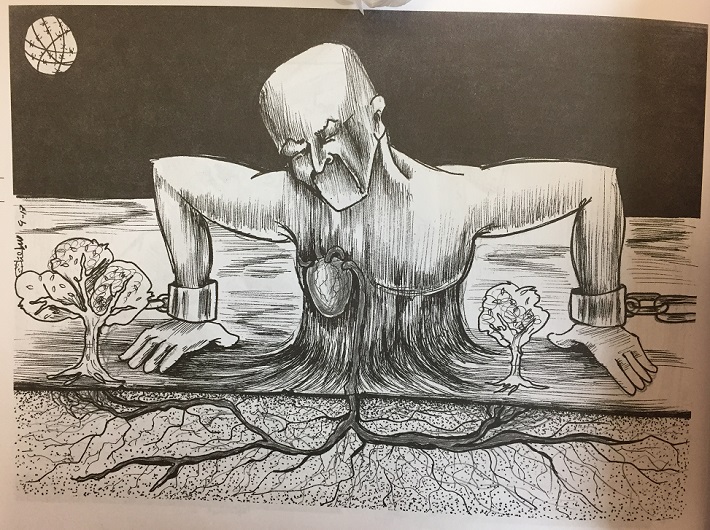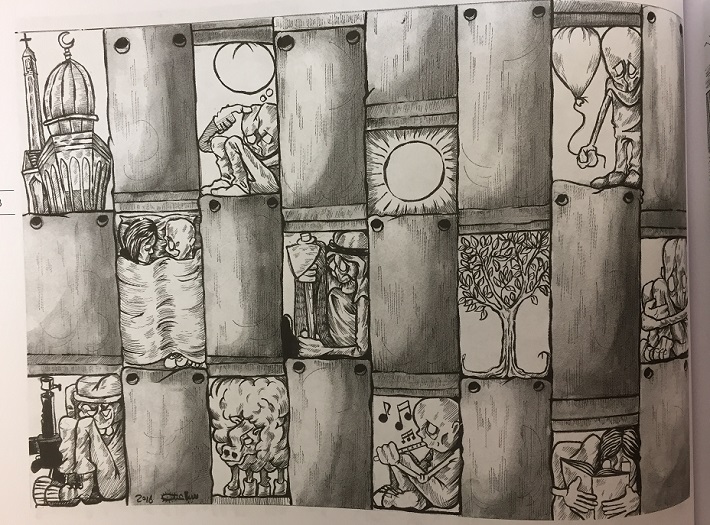
My homeland lives in my heart Image by Mohammad Sabaaneh, photo by Lucy Duncan / Just World Books
Mohammad Sabaaneh is a Palestinian cartoonist, whose book “White and Black: Political Cartoons from Palestine” was recently published by Just World Books. Mohammad was born in Kuwait in 1979 and has been working as a cartoonist since 2002. His work has been published in many Arabic-language newspapers. He has had solo and group exhibitions in Washington, D.C., Great Britain, Spain, Germany, Norway, Holland, Switzerland, Qatar, and Syria. He stopped by our office in Philadelphia on the last leg of his US tour to promote his book. His images are timely as the Palestinian prisoners' who are on hunger strike enter their 40th day on strike. You can purchase Mohammad's book here. - Lucy
Lucy Duncan (Lucy): Tell me about your time in solitary confinement, the impact of that experience and the idea for this book?
Mohammad Sabaaneh (Mohammad): When I was arrested by the Israeli soldiers in 2013, they locked me in a small cell in one of the detention centers in Israel, they locked me in for 3 weeks alone in a cell with rough walls, dim light, the door was so heavy you couldn’t hear what’s happening outside. They wanted to isolate me, it was a kind of torture. They did that so that I as a Palestinian prisoner would confess to anything they asked of me.
That’s why I feel that I should keep my mind working to think about anything besides the prison, because if you keep thinking about the prison and the jail and what’s happening to you, it will be very hard for the prisoner, and the time will pass slowly. I think I am a journalist and an artist and that I will talk about all these details when I am released from the prison. I would talk about the interrogations, the solitary confinement, the family visit and all the things the Palestinian prisoner faces inside the prison. I started to think I would do an exhibition outside when I finished my time inside to talk about the Palestinian prisoner.
It worked. I spent a lot of time just thinking about the art and used the pen and paper I brought with me. The time passed relatively well with me in isolation. When they moved me to the regular prison that’s where you can find more materials, I did more sketches about the political situation outside as well. If I spent two or three months without work, it would be hard to work afterwards.
When I was released, I did my exhibition. I moved my exhibition to Spain, to Jordan, to other cities. Then, because I traveled around the world, I thought I should do something else with my art work. I thought people liked my art work because I am Palestinian and was talking about Palestine and not because the art was so strong. I thought I should care more about the art value. I wanted to improve my sketches and create a new style for my cartoons. I decided to use traditional tools with a new style.
In 2015 I met one of my friends who is a cartoonist for Politico, Kevin Kallaugher, and I showed him my work and he advised me to print them in a book and to do it internationally, not just in Palestine and the Arab world, because the people around the world should know what’s happening in Palestine. We should convey our suffering to people around the world. That’s why I started doing my art work about everything, not just the prison: about the wall, about what’s happening in Gaza, about checkpoints, the discrimination and racism, I included all of it in my book.
Lucy: I looked through all of the drawings. They are so evocative of the feeling of being in Palestine, obviously I’m not living under occupation, but even visiting you get a sense of this atmosphere. The cartoons are all very powerful.
Last night you talked about Guernica, will you talk about that a bit?

Mohammad: I visited Spain and went to see the Guernica, I felt there is a great value to this art work, how this artist did the abstraction of the figures, how he used color and the environment. I thought my first art work was influenced by Guernica, when my friends saw this art work they told me that it looked like The Guernica, I felt so too. I did Guernica with Palestinian features, details. It was a cartoon, an idea for the cartoon. Then I think I found something very important. One of my friends Joe Sacco and some of the artists from the States said this was the first time they saw a comic artist influenced so much by a traditional artist, most cartoonists are influenced by other cartoonists. To use another kind of art and drop it in your art work as a cartoon it’s something new, I hope it’s something new.
Lucy: Talk about the prisoner hunger strike and how you see its power, its impact, its promise.
Mohammad: The hunger strike is something very hard. When I was in the prison, a prisoner told me they would announce for one day a hunger strike, I thought it is something hard, not easy. When they started, I remembered this prisoner who wanted to do it for just one day and I was scared, because it’s something not easy. This is the same message I conveyed in my book. We should deal with this hunger strike by addressing human needs, the prisoners are facing death to enhance their conditions inside the prison, I think no one cares what is happening inside the prison except for the family of the prisoners and some activists around the world. That’s why on all my tours I ask the people to raise their solidarity with the Palestinian prisoner. The hunger strike is something hard, it’s not new in Palestinian resistance. This hunger strike is the longest hunger strike in the Israeli prison, 37 days (40 days as of today). They moved 600 Palestinian prisoners to what looks like a prison hospital, but it’s not a hospital, just another part of the prison. This is why we should support the striking prisoners. Now Trump is in our region, I think he should do something to support the prisoners, to end the hunger strike. But I don’t think he will.

Lucy: You talk about “showing Palestinians in a realistic light, not quite as ordinary people, but not as legendary heroes either.” How does this show up in your work?
Mohammad: I used to draw Palestinian prisoner as a hero, as superman before I was in the prison. When I was in the prison, I missed my family, I missed my work, I wanted to go back to my normal life, I don’t need anyone to deal with me as a hero. I am a human being, I want to go back to my work and my family, my life. That’s why when I started to draw cartoons of the prisoner I drew the human aspect of the prisoner more than to talk about them like heroes. When I started my art work, I wanted to convey the human life in Palestine and what’s happening for the Palestinian.
I would see posters about Palestinians when I was in Kuwait and Jordan, so I heard songs about the Palestinian fighters portraying them as heroes. But we as a people, if we want to support them, we should look at them as human beings that have needs. Even the Palestinian prisoner that are fighters, resisters are simple human beings. These people, they are human beings. They miss their family; they want to fill human needs. They are on the hunger strike to enhance their human conditions. They want to see their family, they want to enhance the healthcare inside the prison.
These things confirm my perspective that we should talk about Palestinian prisoners as human beings. Our society in Palestine, they want to keep the image of us as heroes, as a superman, because heroes don’t need any help, any support. The human being needs our help. When you talk about the prisoners, they are human beings and need others to resist. If they are heroes and super human, then we drop our responsibility to resist, to support. I don’t just want to enhance their conditions inside the prison for the prisoners, they deserve their freedom.

Lucy: You say in the introduction, “I tried to expand my lens to spot the humanity of the occupier, but this effort proved difficult to sustain when an Israeli soldier placed handcuffs around my wrists, or dragged me to an interrogation room, or prevented me from moving from one part of my homeland to the other. With each violation, the occupier denied my humanity to justify his violence to me. Consequently, I could not make the image of the occupier esthetically pleasing, even when I acknowledge that in the process of exerting his political will, the occupier is also occupied.” Can you speak more about this?
Mohammad: When I was in prison, sometime I used to ask the interrogators some personal questions: Are you married, where do you live? Sometimes he would answer general answers and sometimes he would forget that he was an interrogator and start to talk about himself. I asked him these questions, because I wanted to take that risk and we spent lots of hours talking to each other. He did not know that I feel that he is a human being. But he is the oppressor, he does all this oppression to me and I’m here the prisoner.
I used to cross the check point in the winter during the rain and the Israeli soldiers would stop all the Palestinians for two or three hours just to cross one checkpoint and when I went to cross I looked to him and he’s tired also, he wants to go home. The weather is so cold. I think it is difficult to just talk about him as a human being. He is a human being, but he is lifting his oppression against me, not changing the situation. As a Palestinian, as any oppressed people, they fight to change this situation and to be equal with the oppressor, they want to be like a human being. I think they don’t deal with the Palestinian as a human being, they don’t look at us as human beings.
Now with the wall, the next generation of Israeli people will not recognize who is the Palestinian. They will draw a new image of us for their new generation with no direct connection, they will have lost a lot because they will build this image that on the other side of this wall, you will not find human beings. They will raise scared generations, scared of Palestinians. They surrounded themselves with the wall, not just the Palestinians. Always his oppression surrounds my idea of the Israeli because he wants to keep this situation.
Lucy: And the first wall is the one we build around our hearts, positioned as oppressors, that’s the first one, and so there’s this rejection of one’s own humanity. I think you always have a choice about colluding with oppression. There is a cost to being an oppressor, the occupation of one’s heart that makes it possible to enact such violence.
What possibilities do you see for Palestinian freedom?

Mohammad: That’s why I’m doing my cartoons, because I believe an end to the occupation will come. My friend wrote messages from Palestinian refugees to Syrian refugees. He advised the Syrian refugees not to enhance their conditions in the camps, don’t build up, don’t go to school. It is temporary. I believe the occupation is temporary. As I’m sure that the prisoners will get what they are asking for, I believe that all the Palestinians will travel back to their homeland. You will find it in my art work, this hope.
Lucy: To me there is no alternative, there must be an inevitable justice. What are the things that are signs for you living in Palestine of the cracks in the separation wall, of emerging shifting to end the occupation?
Mohammad: You can feel it when you see any uprising, demonstrations or any struggles. Always the Israelis say that the next generation of Palestine will not be involved or won’t care. They want to disconnect our next generation with our national thoughts and principles. In this hunger strike, the young generation are participating, they are facing the Israeli soldier with all the soldiers’ weapons and equipment and the young people stand in front of the soldier and make this confrontation. This is the role to keep our narrative strong and to give it to the next generation, then to convey to people around the world.
Many people are doing a lot in solidarity with the Palestinian prisoner. It’s not enough, but you can find it now. Many people are standing with Palestine, this is not just the result of my work, the work of all the Palestinians, the activists here in the states, the people who believe in our dignity, in our human rights. People in Palestine keep our issues and our dignity to remind the rest of the world of our struggle. Without hope, we will stop. We have hope and will keep working in all fields of resistance, this is our way to get our freedom.

Lucy: After the election of the new President of the United States, I had this kind of clarity: there is no time to not stand in the way, there is no time to postpone joy or sorrow, and there’s no time to waste in building the alternative world we hope to see.
Mohammad: We are not just going to ask for what we can get, but for what we really want. That’s real justice. This is the main idea, not just what we can get, but let’s fight for what we really want, what we really need. We can get our hopes and our dreams. You should believe you are strong to be strong, that’s what I think.